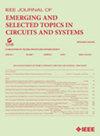Efficient Hardware Architecture Design for Rotary Position Embedding of Large Language Models
IF 3.8
2区 工程技术
Q2 ENGINEERING, ELECTRICAL & ELECTRONIC
IEEE Journal on Emerging and Selected Topics in Circuits and Systems
Pub Date : 2025-03-31
DOI:10.1109/JETCAS.2025.3556443
引用次数: 0
Abstract
Due to the substantial demands of storage and computation imposed by large language models (LLMs), there has been a surge of research interest in their hardware acceleration. As a technique involving non-linear operations, rotary position embedding (RoPE) has been adopted by some recently released LLMs. However, there is currently no reported research on its hardware design. This paper, for the first time, presents an efficient hardware architecture design for RoPE of LLMs. We first explore the similarities between RoPE and the coordinate rotation digital computer (CORDIC) algorithm, while also considering the commonly used quantization scheme for LLMs. Additionally, we propose a hardware-friendly solution to address the issue of excessively large input angle ranges. Then we present a CORDIC-based approximation for RoPE and develop a hardware architecture for it. The experimental results demonstrate that our design can save up to 45.7% area cost and 31.0% power consumption when compared with the fixed-point counterpart, while maintaining almost the same model performance. Compared to the straightforward implementation using floating-point arithmetic, our design can reduce up to 91.4% area cost and 88.9% power consumption, with negligible performance loss.大型语言模型旋转位置嵌入的高效硬件架构设计
由于大型语言模型(llm)对存储和计算的巨大需求,对其硬件加速的研究兴趣激增。旋转位置嵌入(RoPE)作为一种涉及非线性操作的技术,已被一些新近发布的llm所采用。然而,目前还没有关于其硬件设计的研究报道。本文首次提出了一种高效的llm的硬件架构设计。我们首先探讨了RoPE和坐标旋转数字计算机(CORDIC)算法之间的相似性,同时也考虑了llm常用的量化方案。此外,我们提出了一个硬件友好的解决方案,以解决过大的输入角度范围的问题。然后,我们提出了基于cordic的RoPE近似算法,并为其开发了硬件体系结构。实验结果表明,在保持基本相同的模型性能的情况下,我们的设计与定点设计相比,可以节省45.7%的面积成本和31.0%的功耗。与使用浮点运算的直接实现相比,我们的设计可以减少高达91.4%的面积成本和88.9%的功耗,而性能损失可以忽略不计。
本文章由计算机程序翻译,如有差异,请以英文原文为准。
求助全文
约1分钟内获得全文
求助全文
来源期刊

IEEE Journal on Emerging and Selected Topics in Circuits and Systems
ENGINEERING, ELECTRICAL & ELECTRONIC-
CiteScore
8.50
自引率
2.20%
发文量
86
期刊介绍:
The IEEE Journal on Emerging and Selected Topics in Circuits and Systems is published quarterly and solicits, with particular emphasis on emerging areas, special issues on topics that cover the entire scope of the IEEE Circuits and Systems (CAS) Society, namely the theory, analysis, design, tools, and implementation of circuits and systems, spanning their theoretical foundations, applications, and architectures for signal and information processing.
 求助内容:
求助内容: 应助结果提醒方式:
应助结果提醒方式:


